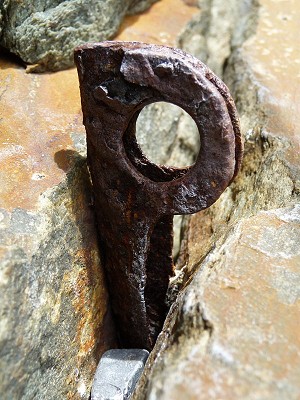

Newer pegs in sea cliff areas such as Pembroke have been badly affected by sea air, the corrosive moisture that cloaks our sea cliffs and speeds up the rusting process on insitu pegs.
In this UKC Forum Thread, Tom Briggs brings up a question about how routes that were previously protected by these pegs will be written up in the two forthcoming Pembroke guidebooks, a comprehensive guide from the Climbers' Club and a new selected guide from Rockfax.
Both organisations took the time to respond on the thread and Alan James (Director of UKClimbing.com and Rockfax) started a new UKC Forum Thread asking for details on some routes for the new Rockfax guide, adding to the information already gathered by his team and the CC.
Both guidebook organisations made it clear that they will do their utmost to provide accurate information on these routes but won't personally inspect individual pegs, instead relying on info gathered from climbers themselves to give a more general feel for the new levels of danger encountered. Grades will be changed where appropriate, and warnings will be stated in the guides where feedback has indicated that insitu pegs are in a bad state.
It is however worth noting that no guidebook company will ever want to take any responsibility for safety or protection of routes - and pegs that look good can fail just as easily as pegs that look bad can hold. There is no definitive answer. Except perhaps not to place any more pegs on British sea cliffs.
In a recent article by UKC user and bolt/metal specialist Jim Titt, published on the BMC website, Jim researches in to insitu pegs, their holding power and how long he would expect them to last. He finds clearly that insitu pegs are not worth pursuing, even in stainless steel and we should now be moving away from this form of protection.
This will mean that some routes will get harder than they are now, as their protection pegs corrode away, but perhaps this is offset in general by the other arrows in the modern climber's quiver? Superb nuts and cams, micro cams, micro nuts, chalk, sticky rubber, indoor training walls, easily accessible training information. We have it all at our disposal, so perhaps we can live without those potential death traps that are choking British trad with an often invisible coat of rust, deep within the rock itself.
Be careful out there. Back up pegs with gear where you can and leave the hammer at home. And don't forget to grab a cream tea from Ma Weston while you're at it!
- You can find updated info for Pembroke Range West and Bouldering on the Climber's Club Website
- You can download a free chapter (Mother Carey's) of the new Rockfax Pembroke Guide on the Rockfax Website













Comments